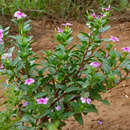Comprehensive Description
provided by Smithsonian Contributions to Botany
Catharanthus roseus (L.) Don
Vinca rosea L., Syst. 10th ed. 2:944. 1759.—Hillebrand, Fl. Haw. Is. 294. 1888.—Butteaud, Fl. Tahiti. 58. 1891.—Drake del Castillo, Ill. Fl. Ins. Pac. 7:234. 1892.—Hemsley, Journ. Linn. Soc. Bot. 30:185. 1894.—Burkill, Journ. Linn. Soc. Bot. 35:46. 1901.—Cheeseman, Trans. Linn. Soc. 6:287. 1903.—Rock, Indig. Trees Haw. 407. 1913.—Wilder, Bish. Mus. Bull. 86:89. 1931.—F.B.H. Brown, Bish. Mus. Bull. 130:234. 1935.
Lochnera rosea Reichenbach, Consp. 134. 1828.—Pancher in Cuzent, Iles Soc. Tahiti 235. 1860.—Reinecke, Bot. Jahrb. 25:667. 1898.—Rechinger, Denks. Akad. Wien 85:330. 1910.—Setchell, Univ. Cal. Pub. Bot. 12:201. 1926.—Wilder, Bish. Mus. Bull. 120:40. 1934.—Christophersen, Bish. Mus. Bull. 128:180. 1935.
Catharanthus roseus (L.) Don, Gen. Hist. 4:95. 1838.—Degener, Fl. Haw. 1933.
Vinca alba Butteaud, Fl. Tahiti. 58. 1891 [nomen nudum; non Noronha, 1790 (= Ervatamia divaricata)].
DESCRIPTION.—Herb, 3–8 dm high, puberulent. Leaves opposite. Petioles 3–5 mm long. Blades oblong to obovate, 3.5–5 × 1.5–2.5 cm, cuneate at base, rounded and apiculate at tip, chartaceous. Flowers axillary, paired. Calyx lobes subulate, 2–3 mm long. Corolla salverform, white or rose, often with a white, red, or yellow center; tube 2.5 cm long; lobes obovate, 1.5 × 1.2 cm, rounded, sinistrorse. Follicles 2, 2.5 × 0.5 cm. Seeds oblong, 2 × 1 mm, finely wrinkled.
RANGE.—Society Islands (cultivated): Raiatea: Moore 207, Uturoa, alt. 1 m, 13 October 1926, flower (white) and fruit (BISH, 2 sheets; MIN). Borabora: Grant 5084, Nunue, Vaitape, alt. 1 m, 18 January 1931, flower (white) (BISH, MIN).
First reported by Pancher (in Cuzent) in 1860. According to Butteaud it was introduced by Bishop d'Axieri. Native of Madagascar. Also cultivated in the Marquesas (!). Naturalized in Makatea, Hawaii, Samoa, and Rarotonga.
LOCAL NAMES.—English: Periwinkle, Madagascar periwinkle. French: pervenche. Samoan: pua ula, according to Reinecke (cf. Fagraea berteriana).
- bibliographic citation
- Grant, Martin Lawrence, Fosberg, F. Raymond, and Smith, Howard M. 1974. "Partial Flora of the Society Islands: Ericaceae to Apocynaceae." Smithsonian Contributions to Botany. 1-85. https://doi.org/10.5479/si.0081024X.17
Comprehensive Description
provided by Smithsonian Contributions to Botany
Catharanthus roseus (L.) G. Don
Catharanthus roseus (L.) G. Don, Gen. Hist. Dichl. Pl., 4:95, 1838.
Vinca rosea L., Syst., ed. 10, 944, 1759.—F. Brown, Flora, 234, 1935.
Lochnera rosea (L.) Reichenbach, Consp. 134, 1828.
Erect herb, up to 0.5 m tall, leaves thin, oblong, obtuse, flowers showy, rose, white, or white with a red eye.
One of the most ubiquitous tropical plants, reputed to have important medical properties. Said to be originally from Madagascar. All three color forms planted in gardens in the Marquesas and frequently naturalized.
SPECIMENS SEEN.—Marquesas Islands: Herbier S.FJ.M. 170 (P).
Nukuhiva I.: Savatier 735 (P).
Uahuka I.: Vaipae’e village, Decker 1662 (US); Hane Village, 10 m, Decker 1951 (US).
Uapou I.: Hoho’i Valley, everywhere, mauve or white, Lavondès 14 (US); west flank of Hakahetau, only one seen, 50–250 m. Decker 2258 (US).
Hivaoa I.: Weedy roadside near beach at Atuona, 1–2 m, escaped from cultivation, Sachet 1205 (US, P, BISH, UH); Atuona, escaped from cultivation, Decker 399 (US, BISH, UC, P); among rocks of seashore (obviously escaped from cultivation), PES (M & A) 122 (pink), 116 (white, red eye) (both BISH, LeB); PES Ex 116 (BISH); Puamau, house yard, 100–200 ft [30–70 m], Decker 538 (US); dry slopes between Nahoe and Eiaone, 100–300 ft [30–100 m], Decker 617 (BISH, US); Hanamenu, near marsh back of beach, Decker 1330 (US, Fo).
LOCAL NAMES.—Perevai (borrowing from the French, pervenche) (Lavondès 14), tihapai (PES 122). English: Madagascar periwinkle.
Cerbera L.
Cerbera L., Gen. Pl., ed. 5, 98, 1754 [=1753].
Shrubs or small trees, leaves crowded at ends of branches, spirally arranged; cymes terminal, frequently with conspicuous pale green bracts; corollas salverform, throat narrow or somewhat dilated; fruit a pair of ovoid drupes, stones covered with spine-like fibers.
An Indo-Pacific genus, one species extending to Polynesia.
- bibliographic citation
- Sachet, Marie-Hélène. 1975. "Flora of the Marquesas, 1: Ericaceae-Convolvulacae." Smithsonian Contributions to Botany. 1-38. https://doi.org/10.5479/si.0081024X.23

